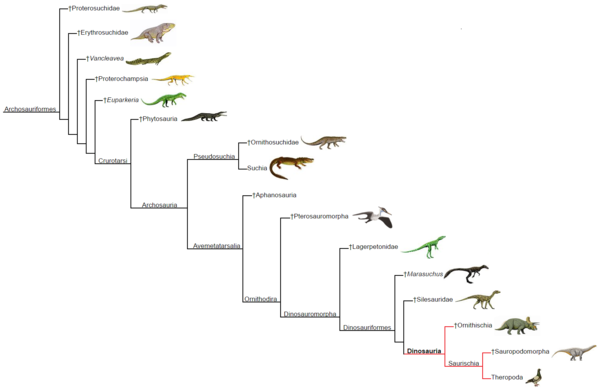In phylogenetics, a sister group or sister taxon, also called an adelphotaxon, comprises the closest relative(s) of another given unit in an evolutionary tree.
Definition
The expression is most easily illustrated by a cladogram:
| Sister group relationships | |||||||||||||||||||||||
|
|
Taxon A and taxon B are sister groups to each other. Taxa A and B, together with any other extant or extinct descendants of their most recent common ancestor (MRCA), form a monophyletic group, the clade AB. Clade AB and taxon C are also sister groups. Taxa A, B, and C, together with all other descendants of their MRCA form the clade ABC.
The whole clade ABC is itself a subtree of a larger tree which offers yet more sister group relationships, both among the leaves and among larger, more deeply rooted clades. The tree structure shown connects through its root to the rest of the universal tree of life.
In cladistic standards, taxa A, B, and C may represent specimens, species, genera, or any other taxonomic units. If A and B are at the same taxonomic level, terminology such as sister species or sister genera can be used.
Example

The term sister group is used in phylogenetic analysis, however, only groups identified in the analysis are labeled as "sister groups".
An example is birds, whose commonly cited living sister group is the crocodiles, but that is true only when discussing extant organisms; when other, extinct groups are considered, the relationship between birds and crocodiles appears distant. Although the bird family tree is rooted in the dinosaurs, there were a number of other, earlier groups, such as the pterosaurs, that branched off the line leading to the dinosaurs after the last common ancestor of birds and crocodiles.
The term sister group must thus be seen as a relative term, with the caveat that the sister group is only the closest relative among the groups/species/specimens that are included in the analysis.
Notes
- A tree diagram inevitably oversimplifies the complicated process of evolution.
References
- Ultrastructural evidence for an adelphotaxon (sister group) to the Neodermata (Platyhelminthes)
- Eernisse, Douglas J. "Introduction to Phylogeny: What is a Sister Taxon?". Biology 404 - Evolution. Department of Biological Science, California State University, Fullerton. Retrieved 4 January 2012.
- Padian, Kevin; Lindberg, David R.; Polly, Paul David (May 1994). "Cladistics and the fossil record: The uses of history". Annual Review of Earth and Planetary Sciences. 22 (1): 63–89. Bibcode:1994AREPS..22...63P. doi:10.1146/annurev.ea.22.050194.000431.
- Kemp, T.S. (January 1988). "Haemothermia or Archosauria? The interrelationships of mammals, birds and crocodiles". Zoological Journal of the Linnean Society. 92 (1): 67–104. doi:10.1111/j.1096-3642.1988.tb01527.x.
- Hughes, J.M. (2011-06-13). "Ancient bird-crocodilian ancestor uncovered". Aves Vitae - The lives of birds. Archived from the original on 26 April 2012. Retrieved 4 January 2012.
- Podani, János (2010). "Taxonomy in evolutionary perspective - An essay on the relationships between taxonomy and evolutionary theory". Synbiologia Hungarica. 5: 1–42.
| Phylogenetics | ||
|---|---|---|
| Relevant fields | ||
| Basic concepts | ||
| Inference methods | ||
| Current topics | ||
| Group traits | ||
| Group types | ||
| Nomenclature | ||